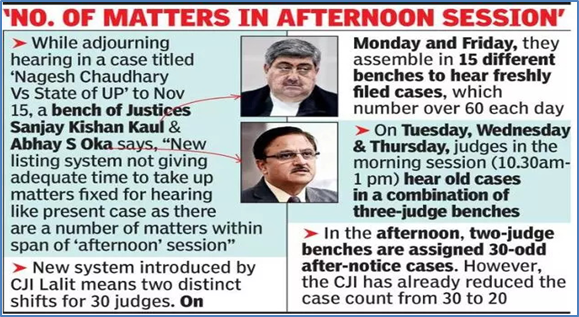In rare move, SC bench order criticises CJI’s listing system
In News:
- In a rare instance, a Supreme Court bench criticised the new case listing system, claiming that it gives judges insufficient time to hear cases.
- The new Chief Justice of India (49th CJI U U Lalit), recently introduced the SC's new case listing method.
Listing system in SC:
Steps involved:
- Registering the case
- First, a party files a petition either physically at the SC’s filing counter or through the court’s website.
- After this, the SC registry - the court’s administrative side that receives and processes documents - examines the petition for any defects in following the court rules and practices.
- When defects are communicated to the parties, they usually have 28 days to correct them.
- Once defects are corrected, the matter is registered before the court and the party gets a petition number.
- After that, the case is sent to the registry for verification, where the registry examines it and looks at things like whether similar cases are pending.
- Listing Section
- Following verification, the matter is forwarded to the listing section, which assigns a hearing date.
- Different types of cases are assigned to different benches. A petition is assigned to a bench based on this.
- On the date of the first hearing, the bench hearing the case may admit the petition or issue a notice to the opposing party to respond.
- According to lawyers, the entire process can take 7 - 10 days in routine cases, assuming parties cure defects within a day and the registry finds no issues in the petition.
- If a case is admitted and regular hearings begin, it is listed in chronological order unless the court sets a specific date for it.
Criticism of the listing system:
- Listing process is arbitrary:
- The listing process is crucial because the SC has a significant backlog and several cases of national importance have been pending for years.
- However, the SC has no objective process that determines when a case is listed.
- While certain guidelines have been laid down for listing cases, many lawyers and even judges have complained that the process is arbitrary.
- Some cases listed faster over others:
- In cases where parties require immediate relief, a procedure known as "mentioning" is used to expedite the process.
- Lawyers can apply to a designated SC registrar for early listing under this provision. If the registrar refuses, they may take the matter to the CJI.
- While the SC put in place an automated listing system in 2019, the CJI, as the master of the court's roster, has full discretion over how cases are listed and may prioritise certain cases.
- Opaque process:
- Various steps of the listing process, such as verification (which are not trackable on the website, it is hard to identify what causes delay) and mentioning (process is not consistent and is constantly being updated), are opaque.
The new listing system:
- After taking oath as the 49th CJI, Justice Lalit pledged to streamline case listing after his predecessor (Justice N V Ramana) admitted that he could not devote much attention to this area.
- The introduction of the listing system by CJI Lalit meant two distinct shifts for the 30 judges.
- They gathered in 15 different benches on Mondays and Fridays to hear newly filed cases, which numbered more than 60 each day.
- On Tuesdays, Wednesdays, and Thursdays, the judges heard old cases involving important legal issues in the morning session (from 10 a.m. to 1 p.m.) in a combination of three-judge benches.
- In the afternoon, the two-judge benches were assigned 30-odd after-notice cases (reduced to 20 later) to be dealt with in 120 minutes, averaging 4 minutes of judicial attention per case.
News Summary:







![ARTICLE 18: ABOLITION OF TITLES - CONSTITUTION OF INDIA [POLITY NOTES]](https://dzcots5lswgyq.cloudfront.net/uploads/1680959574A.jpg)










.jpg)
.jpg)
.png)










